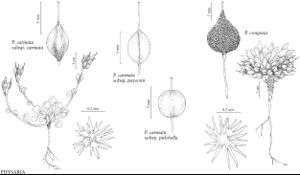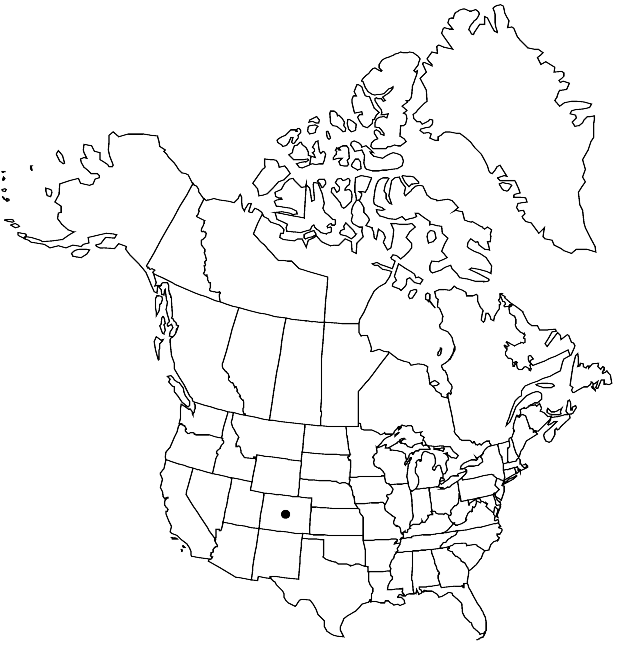Difference between revisions of "Physaria congesta"
Novon 12: 322. 2002.
FNA>Volume Importer |
imported>Volume Importer |
||
| (6 intermediate revisions by 2 users not shown) | |||
| Line 8: | Line 8: | ||
}} | }} | ||
|common_names=Dudley Bluffs bladderpod | |common_names=Dudley Bluffs bladderpod | ||
| − | |basionyms={{Treatment/ID/ | + | |basionyms={{Treatment/ID/Basionym |
|name=Lesquerella congesta | |name=Lesquerella congesta | ||
|authority=Rollins | |authority=Rollins | ||
| + | |rank=species | ||
| + | |publication_title=Contr. Gray Herb. | ||
| + | |publication_place=214: 8. 1984 | ||
}} | }} | ||
|synonyms= | |synonyms= | ||
| Line 28: | Line 31: | ||
|distribution=Colo. | |distribution=Colo. | ||
|discussion=<p>Of conservation concern.</p><!-- | |discussion=<p>Of conservation concern.</p><!-- | ||
| − | --><p>Physaria congesta is found on white, decomposed shale of the Thirteenmile Creek Tongue of the Green River Formation.</p> | + | --><p><i>Physaria congesta</i> is found on white, decomposed shale of the Thirteenmile Creek Tongue of the Green River Formation.</p> |
|tables= | |tables= | ||
|references= | |references= | ||
| Line 37: | Line 40: | ||
-->{{#Taxon: | -->{{#Taxon: | ||
name=Physaria congesta | name=Physaria congesta | ||
| − | |||
|authority=(Rollins) O’Kane & Al-Shehbaz | |authority=(Rollins) O’Kane & Al-Shehbaz | ||
|rank=species | |rank=species | ||
| Line 52: | Line 54: | ||
|publication year=2002 | |publication year=2002 | ||
|special status= | |special status= | ||
| − | |source xml=https:// | + | |source xml=https://bitbucket.org/aafc-mbb/fna-data-curation/src/2e0870ddd59836b60bcf96646a41e87ea5a5943a/coarse_grained_fna_xml/V7/V7_1035.xml |
|tribe=Brassicaceae tribe Physarieae | |tribe=Brassicaceae tribe Physarieae | ||
|genus=Physaria | |genus=Physaria | ||
Latest revision as of 23:29, 5 November 2020
Perennials; (relatively diminutive, strongly condensed); caudex (buried), simple or branched, (stout, thatched, thickened with persistent leaf bases); densely pubescent, trichomes (appressed, stiff), 4- or 5-rayed, rays fused at center, (mostly bifurcate). Stems simple or few from base, decumbent to ascending, (arising laterally from a tight hemispherical tuft of leaves), to 0.15 dm. Basal leaves similar to cauline, (erect, surfaces silvery). Cauline leaves (ascending, subsessile); blade linear-oblanceolate, (0.6–)0.8–1.3(–1.5) cm, margins entire, (apex acute to narrowly obtuse). Racemes strongly congested, (often sessile or nearly so, lateral to leaves). Fruiting pedicels (erect or ascending, straight to slightly curved), 3–6 mm. Flowers: sepals (loosely erect), narrowly oblong, 3–4 mm; petals spatulate, 5–6 mm. Fruits ovate, compressed (latiseptate) on margins and apically, 4–5 mm; valves pubescent, trichomes densely appressed; ovules 4 per ovary; style 1–1.5 mm. Seeds plump.
Phenology: Flowering Apr–May.
Habitat: Barren knolls with pinyon-juniper
Elevation: 1800-2100 m
Discussion
Of conservation concern.
Physaria congesta is found on white, decomposed shale of the Thirteenmile Creek Tongue of the Green River Formation.
Selected References
None.

